The basic operation of a double action revolver is pretty simple and straightforward, but there’s still a lot of room for operator technique. This is certainly true when it comes to reloading the revolver in an emergency.
We’ve written before about several reloading techniques, to include the Universal Revolver Reload and StressFire systems, but we haven’t spent much time discussing the specifics of how to use a speedloader or strip loader as part of those techniques. Therefore, we thought it might be worth a few minutes to discuss some miscellaneous tips and techniques for efficient speedloader and strip loader use.
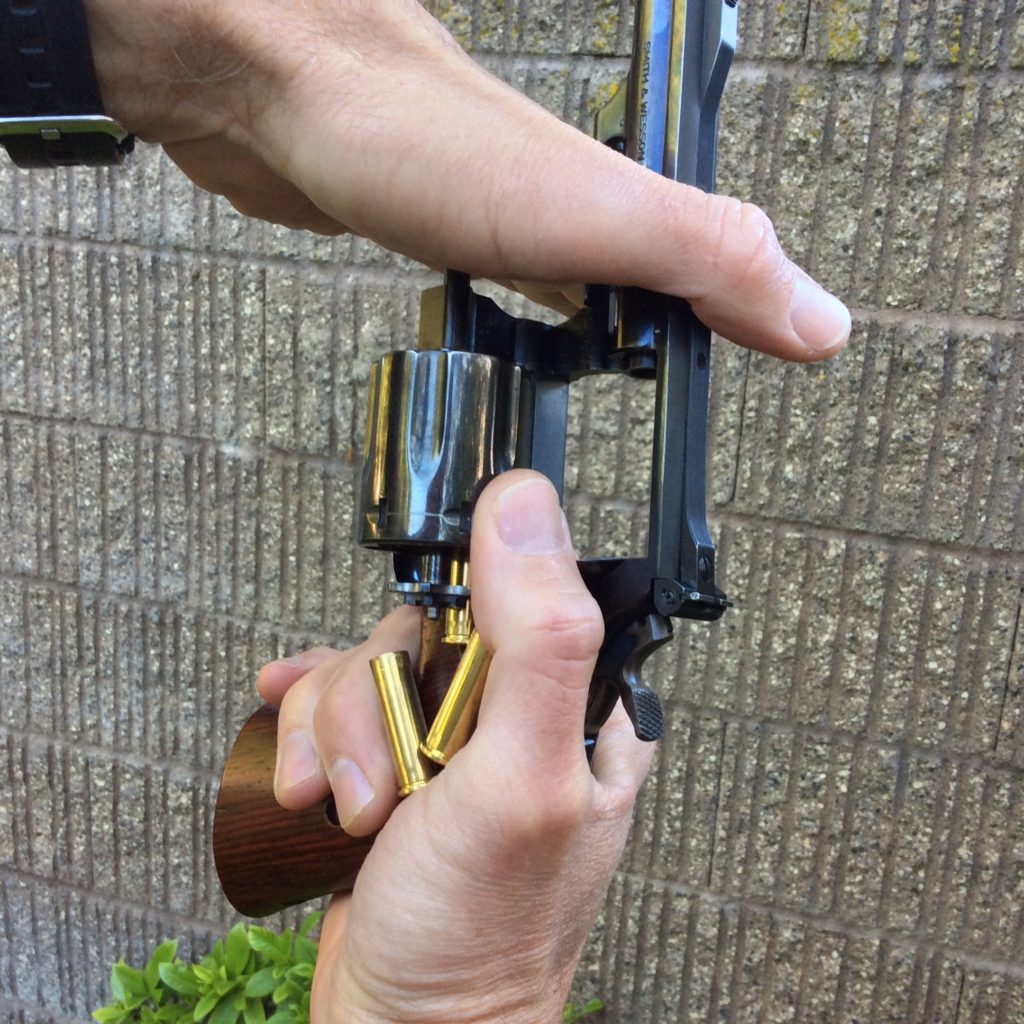
We’re quick to recognize there’s a lot ways to skin the cat, and a lot of different loader designs, so we may not hit on your favorite method or widget here. If we don’t, please feel free to share your additional tips and observations in the comments, below.
Choosing Sides
The first thing to consider about carrying a speedloader is to determine which hand is going to operate it, and then ensure the loader is carried on that side of the body.
I recognize there’s some popular techniques for right-handers in which the gun is retained in the right hand and the left hand operates the speedloader, but my preference has always been to operate the speedloader with my most dexterous hand, so I carry my speedloaders on my gun side as a right-hander. If you’re a fan of loading with your left hand, as a right-handed shooter, then you’ll definitely want to carry your loader on your left side.
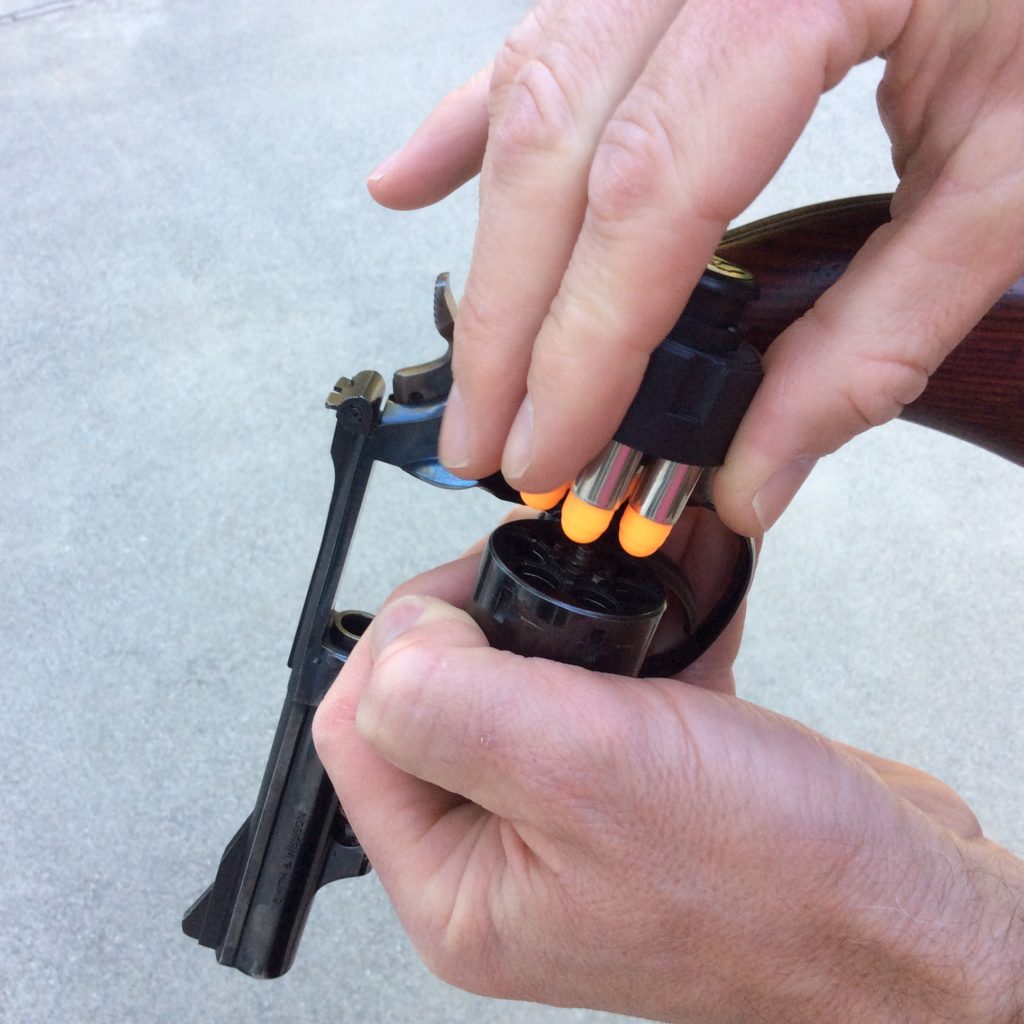
This process seems to work best when the more dexterous hand operates the loader, but with good training and practice, you could load with the support hand as well
If you’re a left-handed shooter, you’ll probably follow my lead and carry your speedloader on your gun side, since it seems like the most efficient way for a lefty to load a swing-out cylinder is to transfer the gun to the right hand, and load with the left, then pass the gun back to the left hand to resume firing.
Location, location, location
The location you choose to carry your speedloader will vary with your build, holster choice, physical limitations, dress, concealment considerations, and other variables. There’s no “one size fits all,” here.
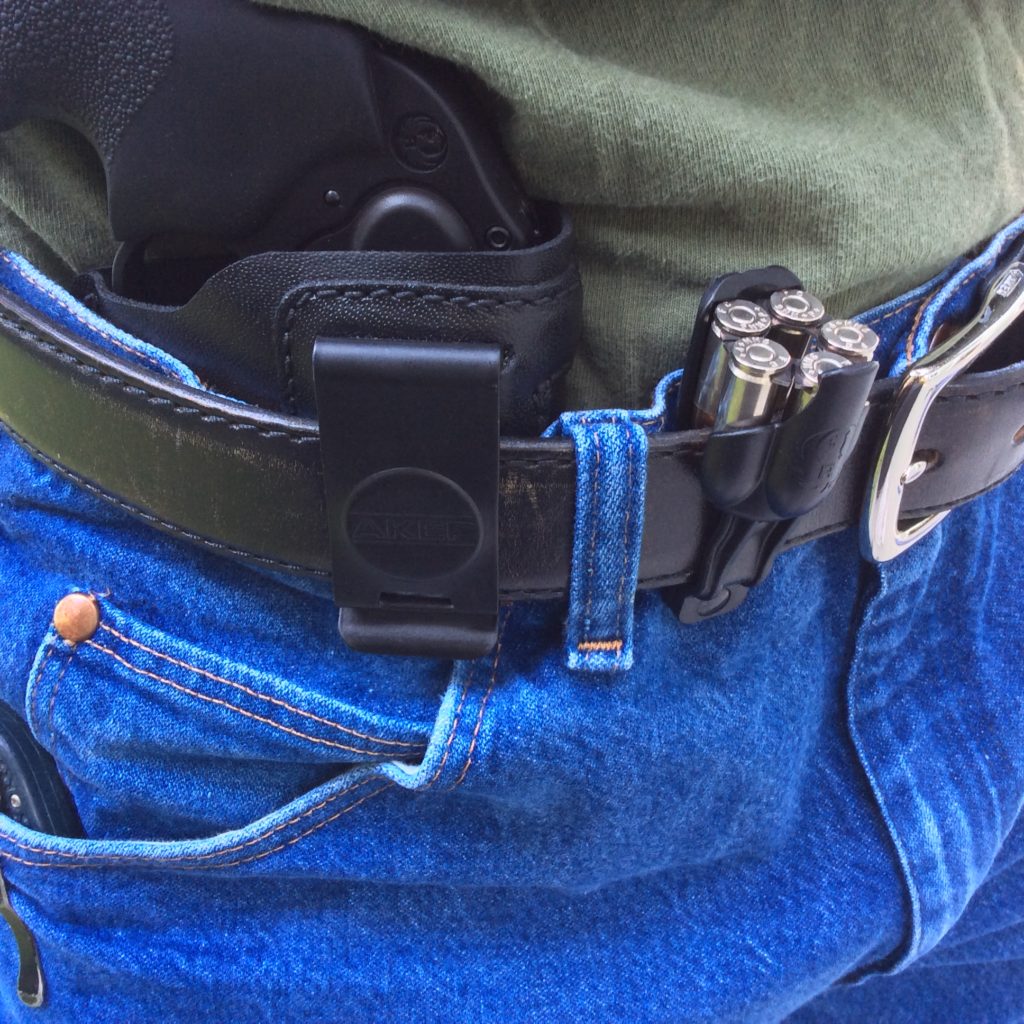
When possible, I prefer to carry my round speedloader forward of my gun, around 1 O’Clock on the belt. Putting it forward of the gun guarantees that it won’t interfere with obtaining a good grasp on the gun during my drawstroke. It also puts the loader in a position where it can be quickly accessed with either hand, which might be important if my primary side is injured.
When my speedloader is a strip loader (like the Bianchi Speed Strip), I will typically carry it in the coin pocket of my jeans. This places it aft of the gun, but the flat shape of the loader doesn’t infringe on the space around the grips, so it presents no problem for drawing.
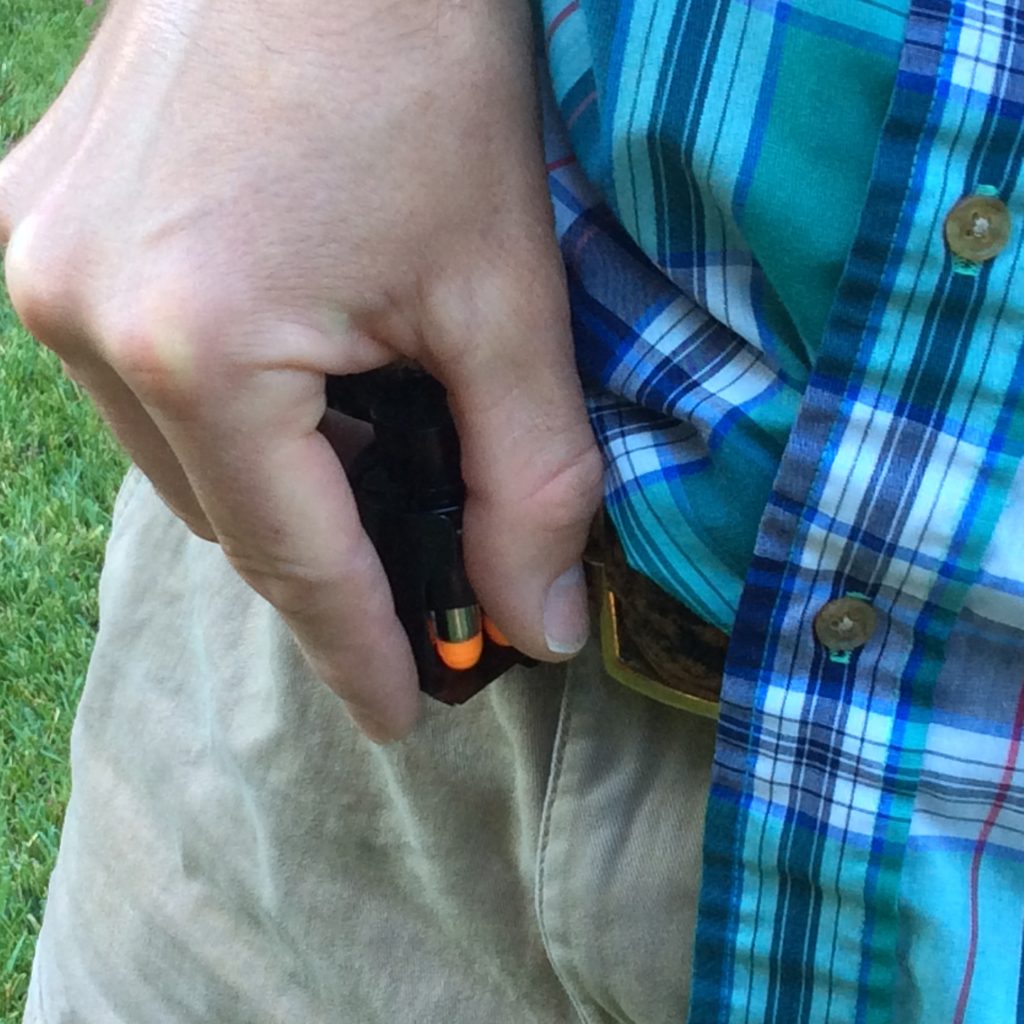
Putting the loader somewhere between 10 and 2 O’clock makes it faster to access than having to reach back to your 3 – 9 line, or behind it. It also allows you to stage the gun very close to the source of spare ammunition for reloading, which can enhance your coordination and speed. In my standard reload technique, I’ll take my unloaded gun (which is in my left hand) and index it against my body somewhere around 12 to 1 O’ clock, while the right hand moves to access the loader. When the loader is obtained, the gun is waiting right there next to it, ready to accept the new cartridges. Using a tactile index for the gun positions it in a consistent manner, which aids in efficiency, and staging it next to the source of ammo decreases the amount of “transit time” for the reload to reach the gun.
Pocket Carry
Many shooters are happy to carry their speedloaders loose in a pocket. This is certainly a viable option, but it comes with a few cautions.
First, you’ll find that certain speedloader designs are prone to losing some or all of their contents when carried loose in the pocket, so be careful about what you use. I’ve had this happen with both strip-style and round body speedloaders over the years. In example, one of my favorite loaders has always been the (now discontinued) Dade speedloader, but it has a tendency to dump its contents when carried loose in a pocket, so I only carry this design in a pouch. If pocket carry is required, I’ll switch to a Safariland Comp I/II instead.
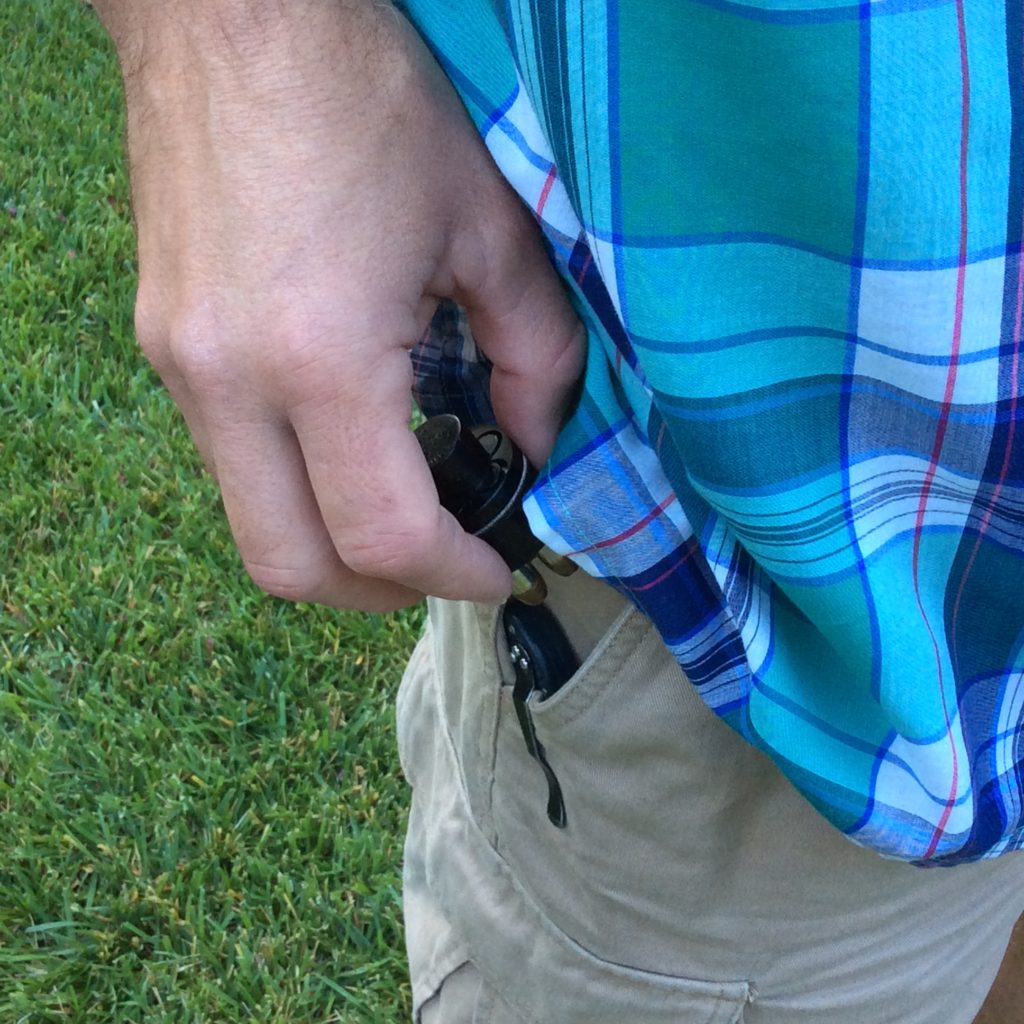
Another caution about pocket carry is that you really don’t want to carry anything else in the pocket besides the loader. The first danger of carrying extra stuff is that you’ll come out with a handful of it on the draw, and it will slow down the loading process as you separate the wheat from the chaff. The other danger is that something might trigger the release mechanism in your pocket, or get caught up in the loader and jam things up. So, leave the keys, coins, and other stuff for another pocket, and carry the loader by itself.
It’s important to inspect the loader regularly, to ensure proper condition and operation. Loose loaders get banged around, and can get damaged, so check for cracks and such. One common failure I’ve experienced is the little tab on a strip-style loader breaking off, which isn’t a major deal, but it could slow things down a bit. You should also make sure your round loader isn’t clogged with pocket lint—it doesn’t take much to jam one up, so keep it clean.
It’s also important to check your ammo to make sure it’s in good condition. When a loader is carried loose in a pocket, ammunition with exposed lead tips can become deformed (i.e., hollowpoints can get crushed or collapse), hollowpoint cavities can get clogged with lint, cases can get dented, moisture can contaminate powder, or corrosion can take hold. Your speedloader and its payload are lifesaving equipment, so inspect them frequently.
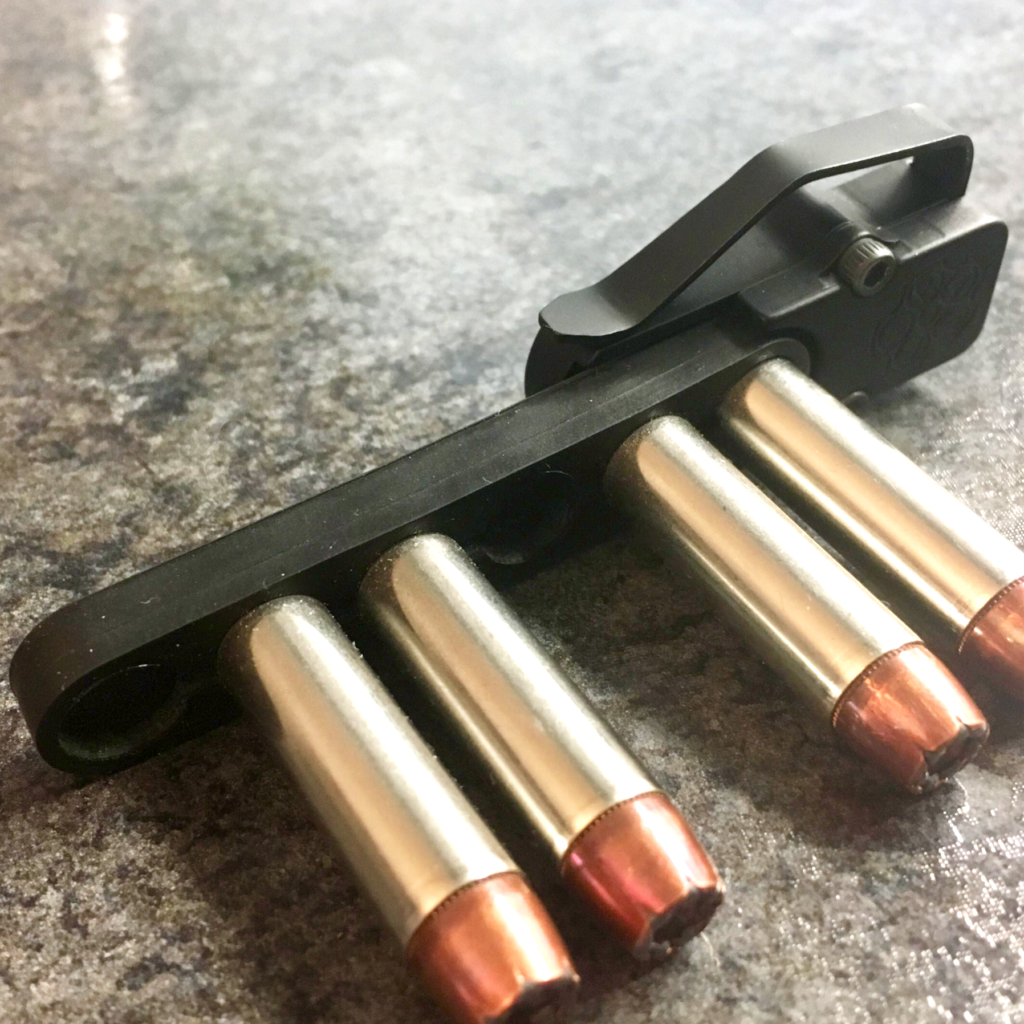
The NeoMag Revolver Ammunition Strip Carrier (RASC) is a new option for those who choose to pocket carry their spare ammo
I can’t leave pocket carry without mentioning the innovative RASC adapter for strip loaders, which makes it easy to carry a strip loader in a consistent location and orientation. If you’re a fan of both pocket carry and strip loaders, you need to check that out.
Kangaroo carry
Carrying your speedloader in a pouch solves some of the problems of pocket carry, but can create others.
On the positive side, a good pouch can better protect your speedloader from physical damage and the elements. It will protect it from being accidentally discharged, and will also keep it oriented properly for the most efficient draw (somehow, a loader always winds up facing the wrong direction in a pocket, which can slow things down or even cause you to accidentally fumble or prematurely discharge the loader).
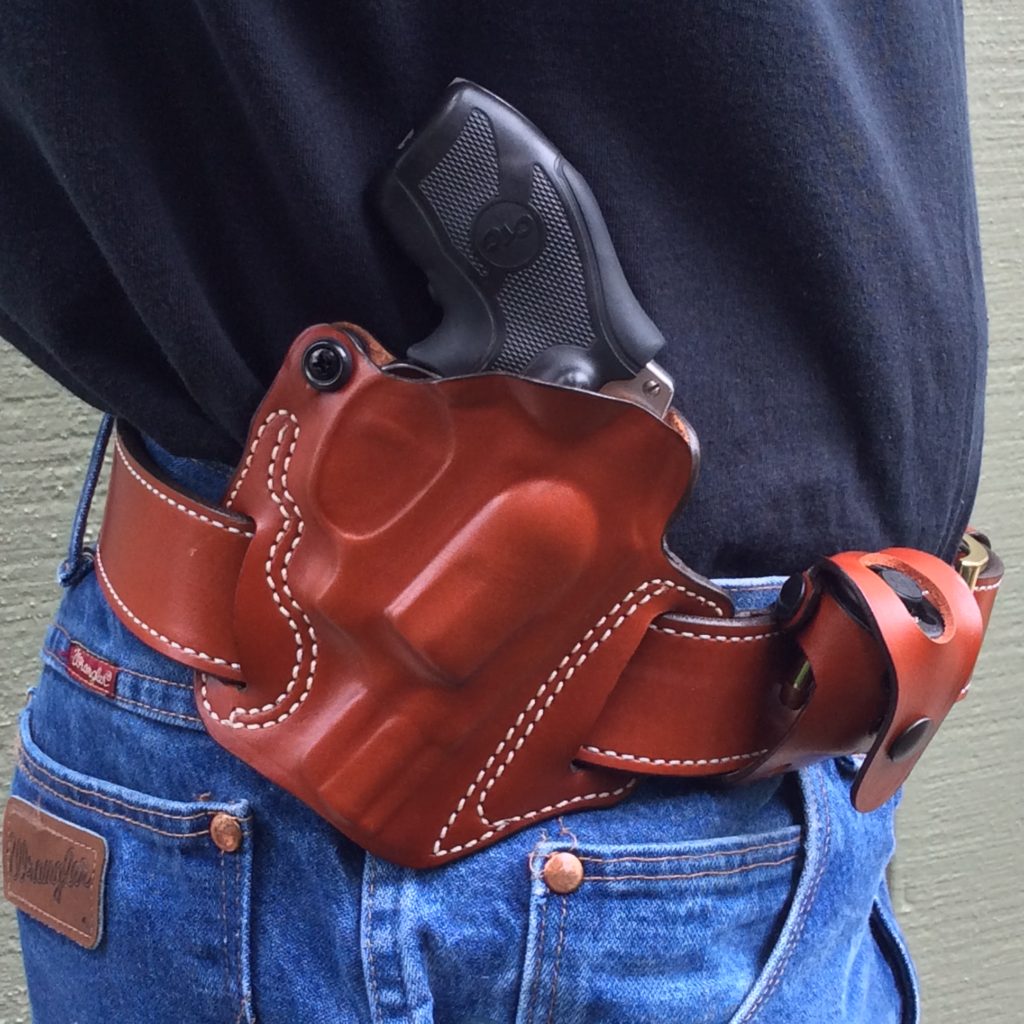
The problem with some pouches is that they’re bulky and can be more difficult to conceal than just throwing the loader in a pocket. Also, some styles of pouches are incompatible with certain types of loaders. For example, the “split-six” style pouches, in which the loader straddles the top edge of the belt, are often incompatible with loaders that have a central post release mechanism. Loaders of this type (including the Safariland Comp series and SL Variant) can sometimes discharge in the pouch when the edge of the belt presses on the post, so it’s usually better to use a twist-style loader (like the HKS or 5-Star) with these carriers.
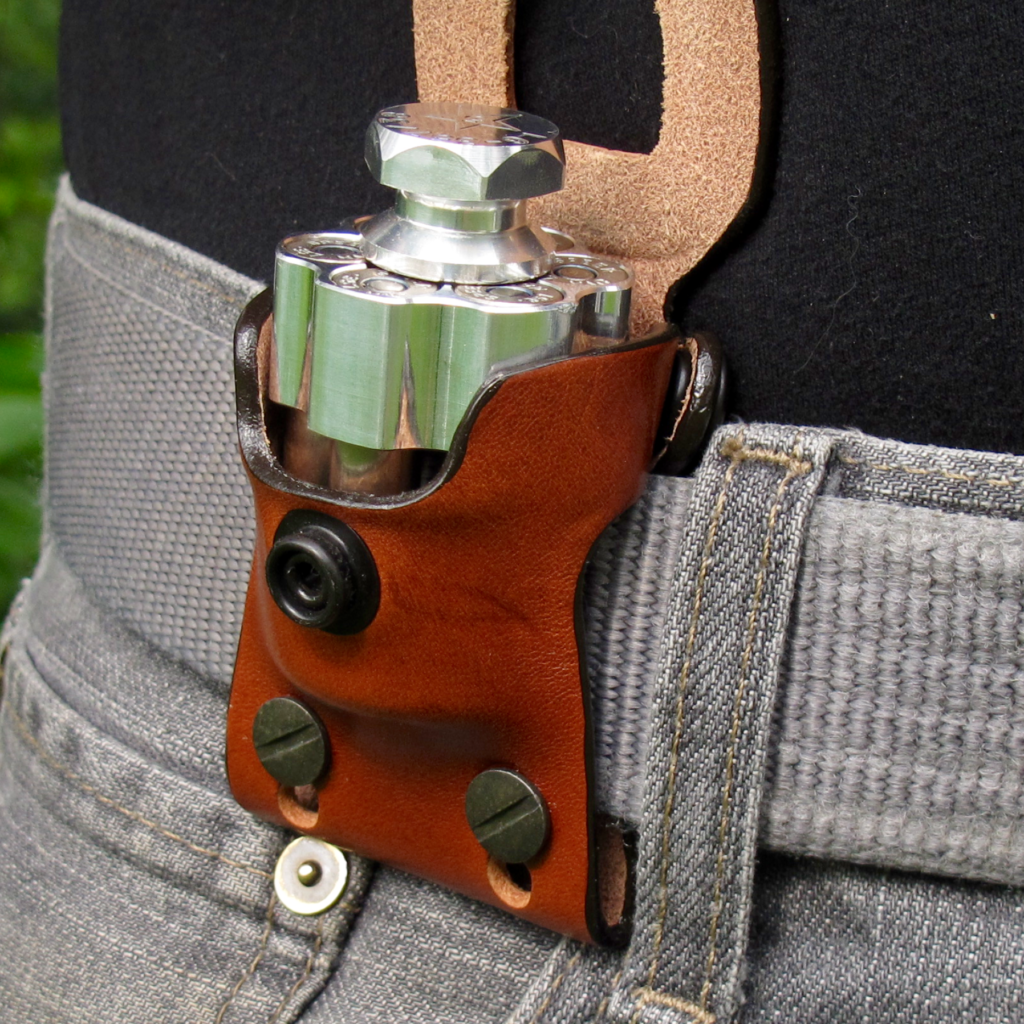
One thing to be aware of if you use a leather pouch is the possibility of verdigris buildup. Verdigris is the green, waxy gunk that builds up when the tanning acids in leather react with metal. If you don’t perform proper inspections and maintenance on your gear, or rotate your carry ammo frequently enough, you might have verdigris accumulate on your cartridges where the case or bullet contacts the leather. This sticky mess might prevent your cartridges from seating in the chambers, so be careful to inspect regularly and clean or replace your ammo as required. As a young man, I saw more than one copper who didn’t heed this lesson, and wound up paying for it later—thankfully, on the range, for these men, but it could have been more serious if they had entered into a fight.
Presenting the loader
Back in the ‘80s, Mas Ayoob taught me a speedloader technique that worked very well, and I’ve used it ever since. In Ayoob’s preferred technique, the speedloader is grasped by its body, not by any knobs or release mechanisms on top. The thumb traps the loader against the fingers, which remain straight as they grip the loader’s body. The fingertips extend past the tips of the cartridges, so they can guide the loader into alignment with the cylinder and its chambers.
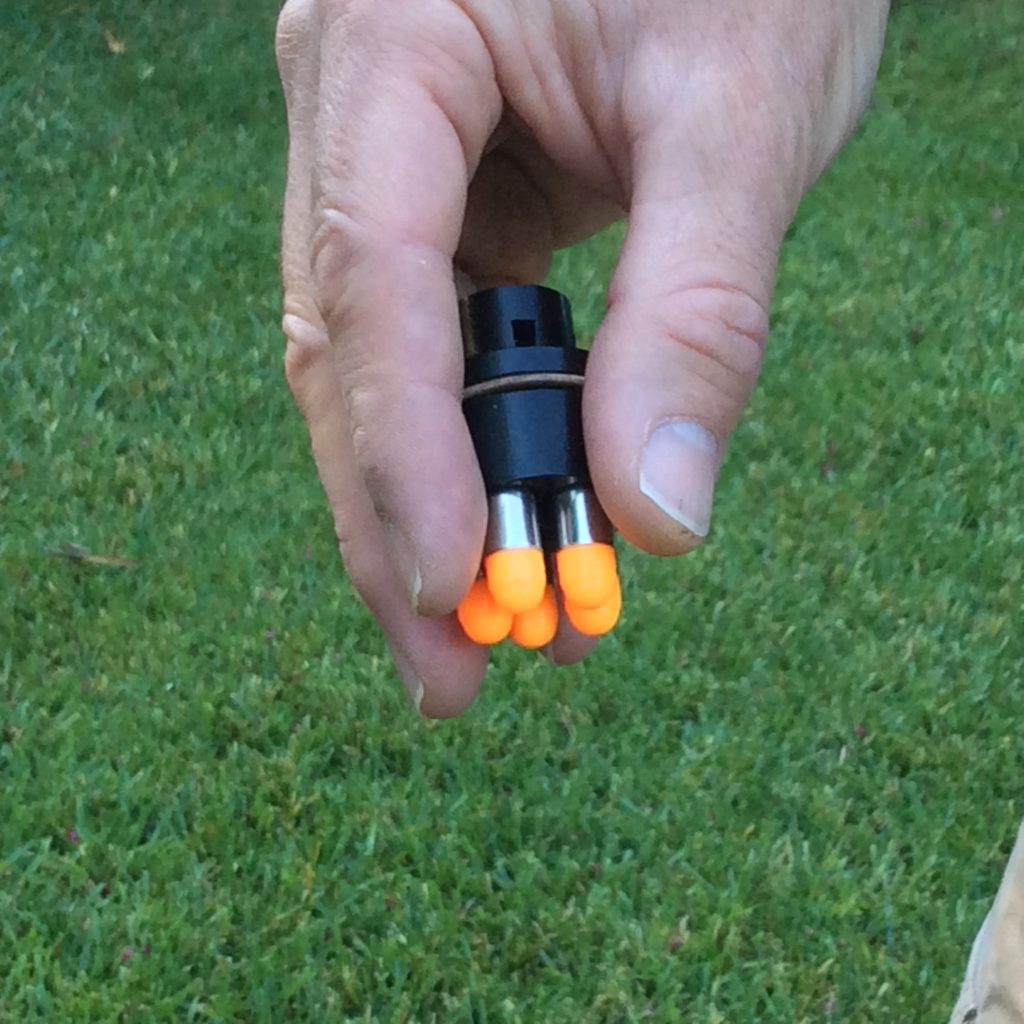
In practice, the fingertips find the edge of the cylinder and stabilize the loader in position. The loader is then lightly turned, as required, to line up the cartridges with the chambers. With practice, a partnership develops between the hands where the thumb and fingers stabilizing the cylinder can feel the flutes on the outside of the cylinder (which are located in between chambers) and the fingertips holding the loader can feel the tips of the cartridges. These felt indices can allow you to mate the loader to the cylinder in a manner where you’re often pretty close to getting the cartridges directly into the chambers, and it only takes a little bit of work to fine tune things if you missed. As RevolverGuy Dean Caputo explains, the strong hand index finger (lying between adjoining rounds in the loader) finds the weak hand thumb (which is indexed on the flute), and with perhaps a slight adjustment, the cartridges find their chambers . . . even without looking.
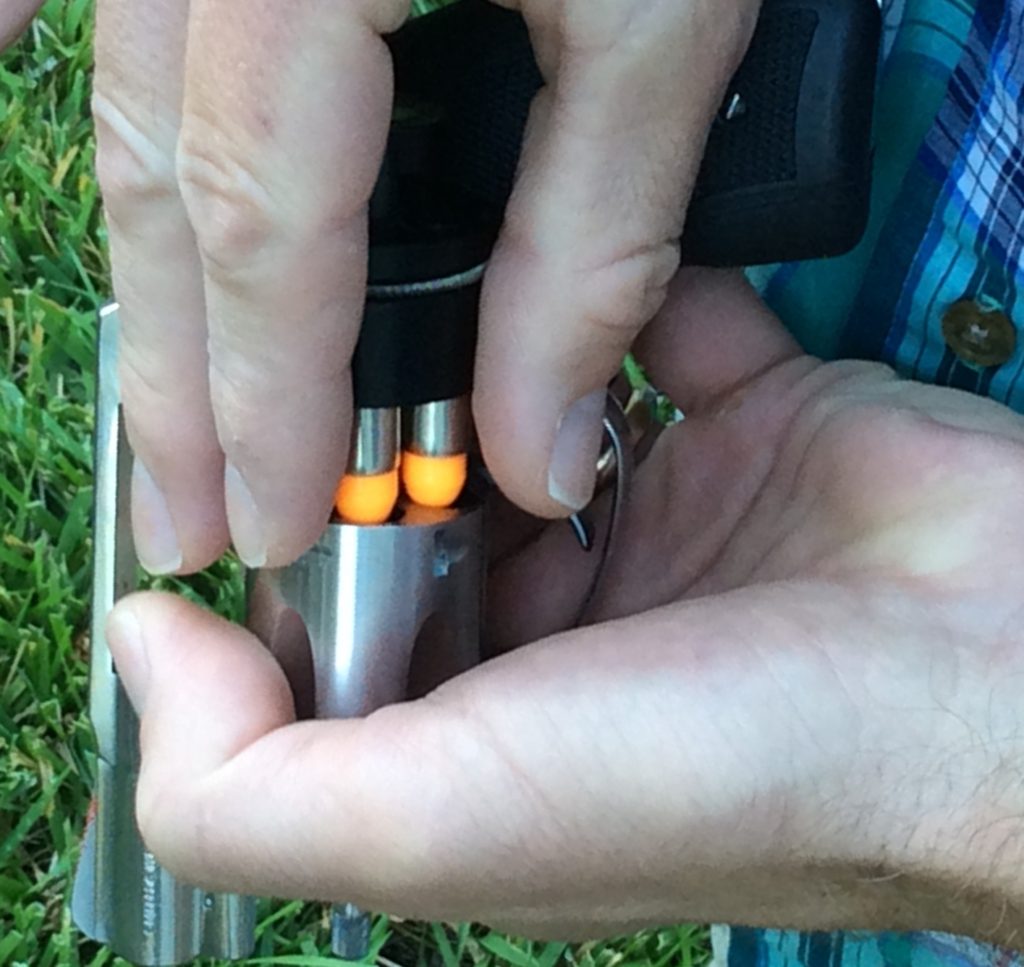
One trick that can help when indexing the loader to the cylinder is to focus on getting two cartridges started into their chambers. It might help to angle the loader a bit to facilitate this. If you can get two started, then when you square up the loader to the cylinder, the rest will naturally find their chambers. This can be easier than trying to stab 5 or 6 cartridges into their chambers at once.
If you pluck a loader from a pouch by the release knob, you run the risk of accidentally discharging the loader before you’re ready to. Additionally, it can be tougher to align the cartridges with the chambers because you don’t have a feel for where they are in relation to the empty holes. It can certainly be done, but it’s a more delicate operation which requires a good, clear look and a little more dexterity to stab the cartridges into the chambers. In my experience, it’s not as reliable under stress, and in reduced lighting conditions, as the Ayoob method is.
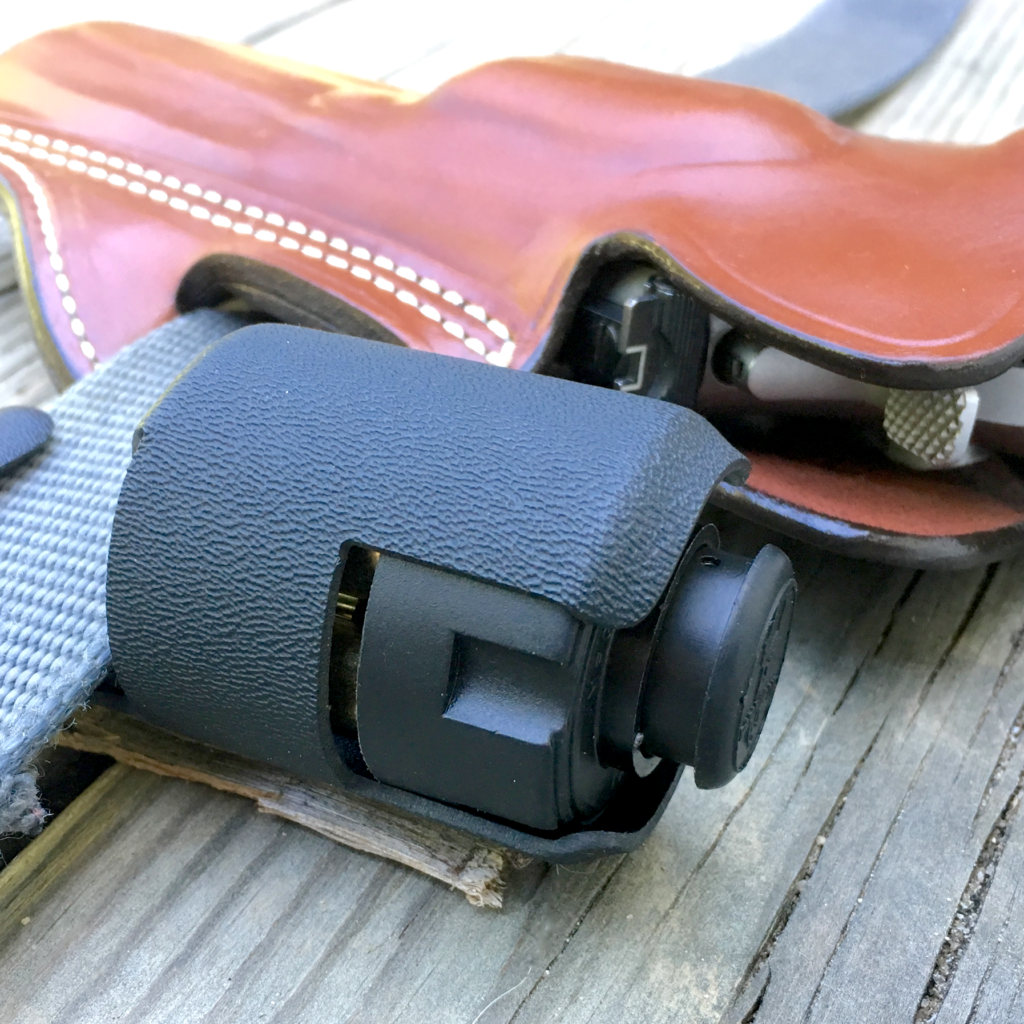
One requirement for the preferred method is to adopt a pouch with enough clearance on the sides to obtain the desired grip on the loader body. Some pouches are built with high sidewalls that only leave the release knob on top of the loader available for purchase. Sometimes you can trim them down with a knife to make things work, but it’s better to find a pouch that is built the right way from the start.
Charging the gun
Once you have the round body loader properly indexed, just send it home with a push (for a push-style loader) or move your hand to the release knob (for twist-style loaders) and actuate it.
It’s helpful to keep the gun oriented in the vertical plane to get the cartridges to feed properly into the cylinder. This is critical for loaders that rely on gravity to seat the cartridges, but also important for the spring-assisted loaders.
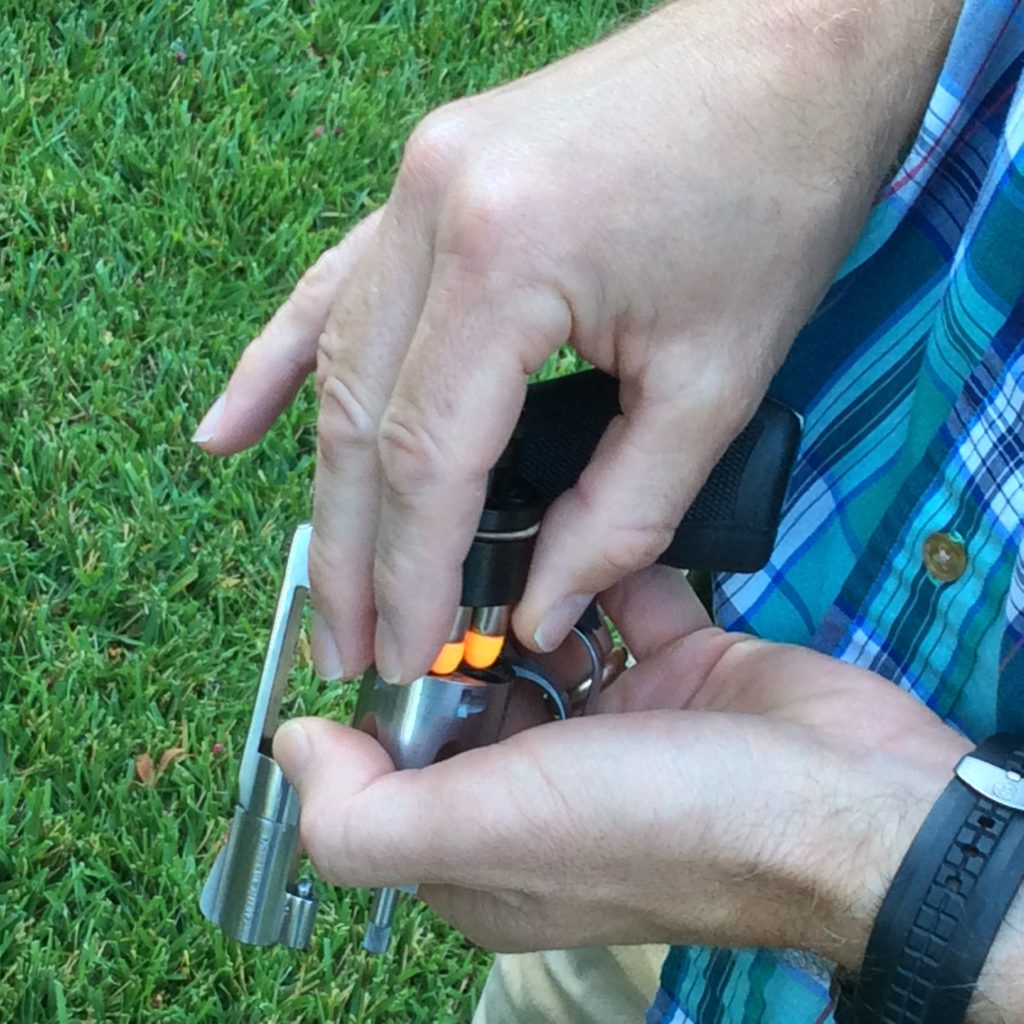
Some reloading techniques (like the StressFire) do a better job than others of allowing you to keep the gun straight up and down, but with careful attention, you can make most techniques work well. One thing that seems to help is to hold the gun against your body in a consistent place, instead of letting the gun “float” in space in front of you. Anchor the gun against your body and get that tactile index, to ensure the consistent positioning that will make your reloads more efficient and speedy, even in reduced light. This will also help you to pull the loader straight up and out, instead of at an angle, which will decrease the possibility of pulling rounds back out of the chambers.
Let it go
Once the rounds are in the gun, release your grasp on the loader and ignore it. When the cylinder is closed up, the loader will fall away like the useless trash that it is now. I haven’t found a need to make a separate and exaggerated movement to toss it aside—I just release my grip on it, close the cylinder, and reacquire my shooting grasp, letting the loader fall away on its own. Economy of motion will save you precious time, here.
Strip Loader Essentials
We haven’t discussed techniques for the strip-style loaders much, but there’s several options worth considering.
First, there’s a variety of techniques for how to prepare the strips. You can load them up to full capacity if you like, but some folks prefer to carry less ammunition on a strip in order to create space in between the cartridges for better control of the loader, or to create a/larger tab for holding it on the end. For example, a 6-shot strip might be loaded in this sequence, to create a hold in the middle and on each end: Tab – 2 loaded cells – 1 empty cell – 2 loaded cells – 1 empty cell. Another alternative might be to fill the middle four cells, and leave the two end cells open.
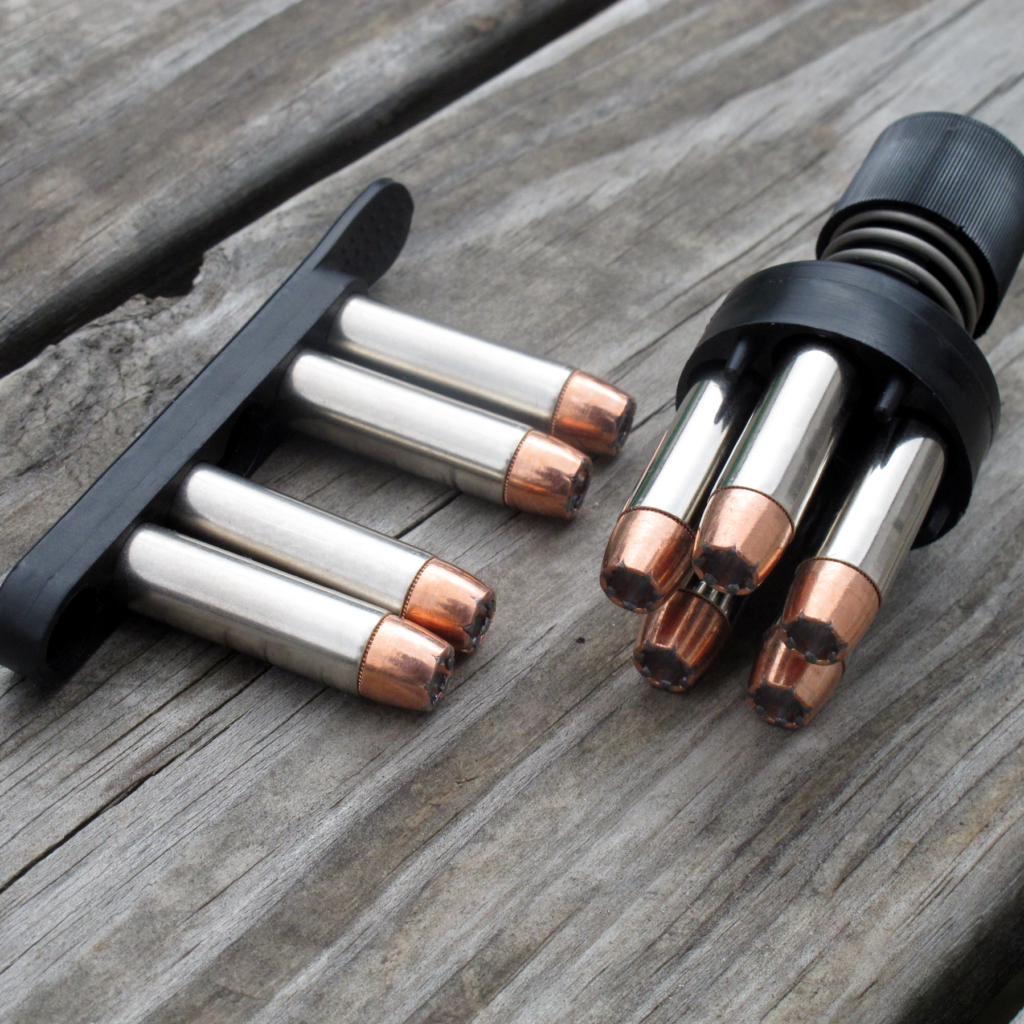
The advantage of these techniques is that the loader can be indexed in the same way, no matter which direction you find it in your pocket—it becomes “reversible,” so to speak. In the one version, the extra space in the middle allows you to pinch it between your thumb and index finger, for very positive control of the loader.
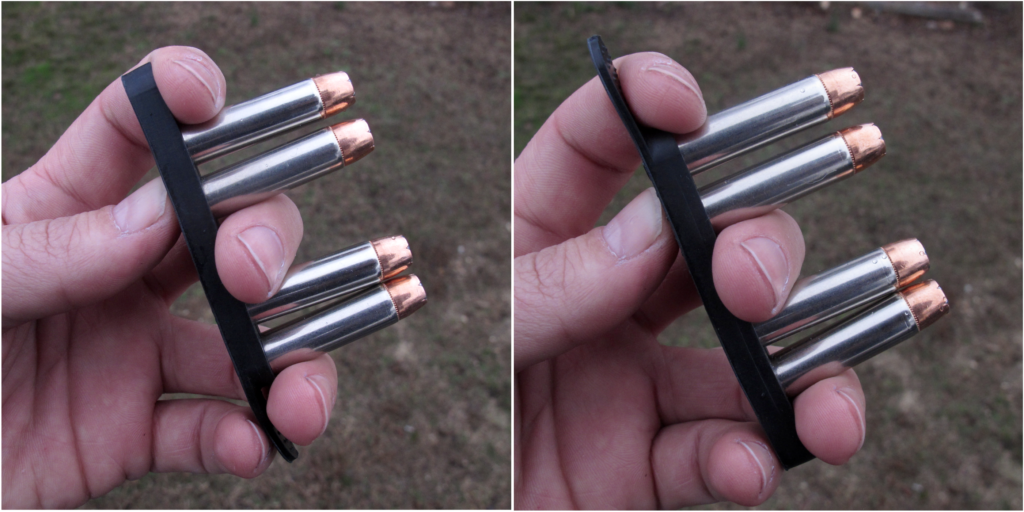
The disadvantage of these reduced capacity techniques is obvious—you’re carrying less ammo in the strip. However, proponents of the technique argue that it’s better to get two pairs into a 5-shot gun quickly and positively, and skip the 5th empty chamber, than it is to carry the extra round(s) and fumble the reload or take the extra time to complete it.
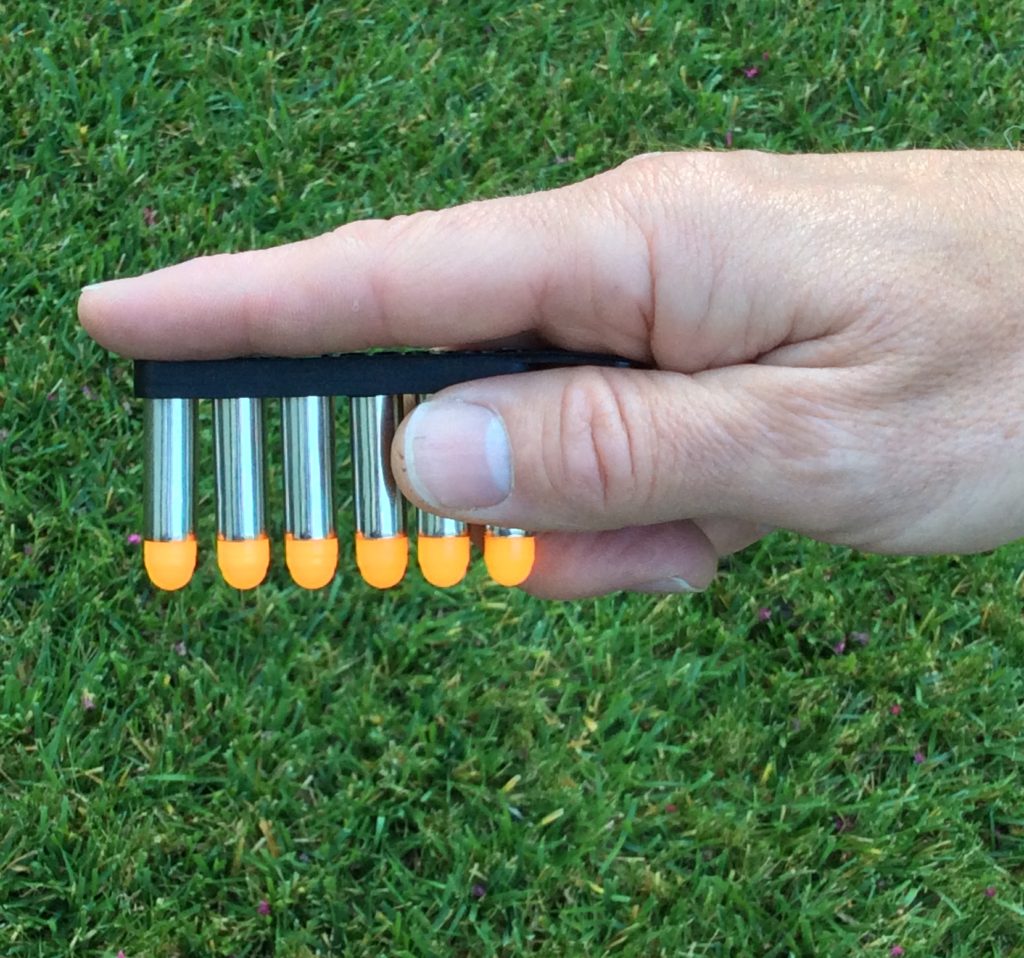
Mas Ayoob taught me a method for ammo strips back in the ‘80s that he called the “scalpel” method. The index finger is laid along the spine of the loader and the loader is grasped by pinching it between the thumb and middle finger, which wraps under and encircles the tab end of the loader. Holding the loader like this is akin to how surgeon holds a scalpel, hence the name.
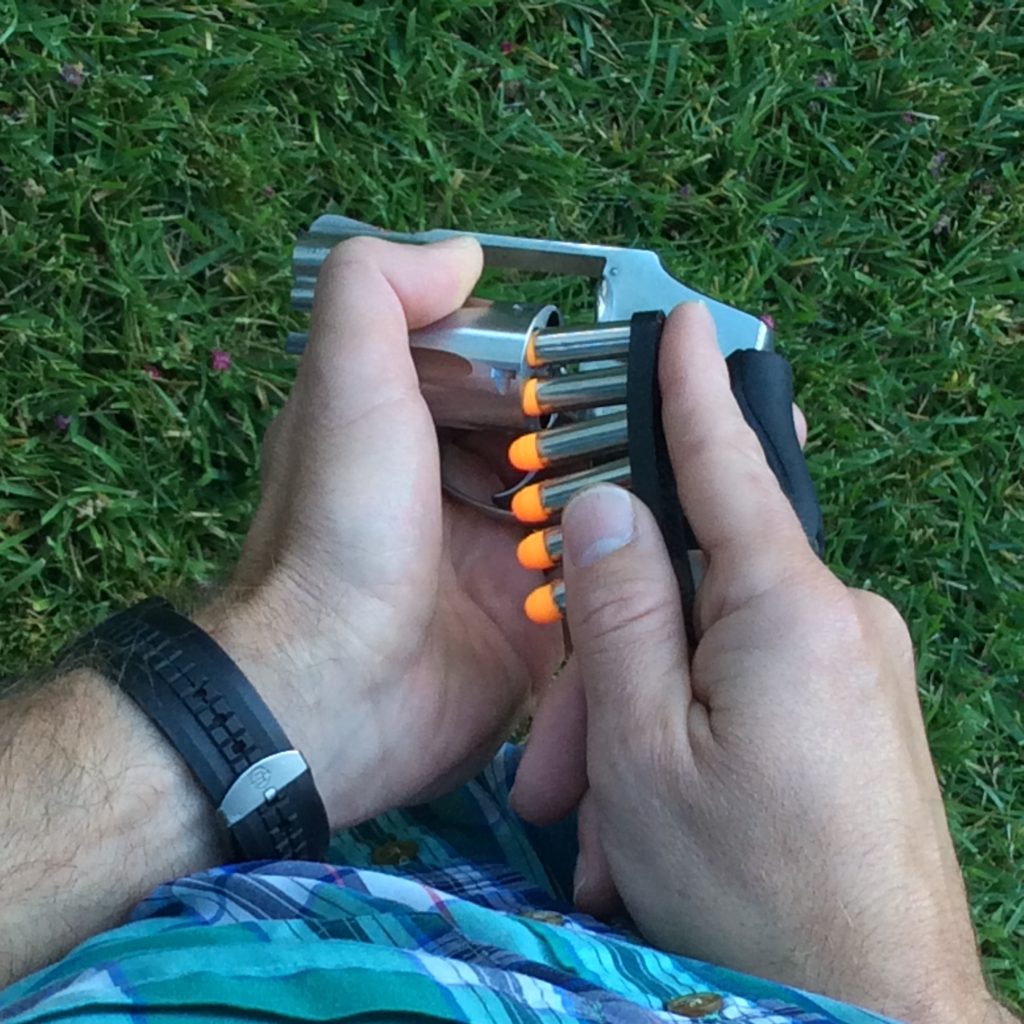
In practice, the loader is put into place, and peeled up with the index finger remaining on the spine to provide the necessary fulcrum and pressure. In Mas’ technique, the cell next to the tab is left empty to create a bigger handle and enhance control, so a 6-shot gun will only get topped off with a maximum of 5 rounds using the typical loader. However, if you buy one of the extended, 7 or 8-round QuickStrips from Tuff Products, you can still prep the loader with enough ammo to “fill ‘er up.”
An alternative to the “Scalpel” is to hold the loader with your thumb on the back of the spine. Your thumb will then push the round(s) into the chamber(s) and act as the fulcrum to peel the loader away from the cylinder. This method works well too, and is preferred by those who like to stage their strips with empty cells, for easier manipulation, as previously discussed. Personally, I find that the thumb does a better job of getting the cartridges lined up with the chambers than the straight finger does in the “Scalpel” method.
Universal truth
I’m sure there’s more bits of speedloader wisdom out there in the RevolverGuy audience, so let us hear from you about your preferred loaders, pouches, and techniques for using them.
We may not agree on the best widgets or methods for getting the job done, but I think most of us will agree that it’s a good idea to carry at least one reload for your gun at all times. I always carry a spare magazine for my autoloaders (primarily as a reliability measure, although I like having the extra ammo, too) and a spare strip or speedloader for my wheelguns (since they’re not fat on capacity, and I wouldn’t want to be standing around with a mostly/empty gun when the smoke clears—or worse yet, before the fight is over).
I think it’s a best practice, and I’d like to encourage you to do the same, if you’re not already. I should emphasize though, that the extra ammo in your speedloader won’t help you if you’re not practiced on how to use it, so make sure you include it as part of your dry practice and live fire practice.
Train hard and be safe out there!

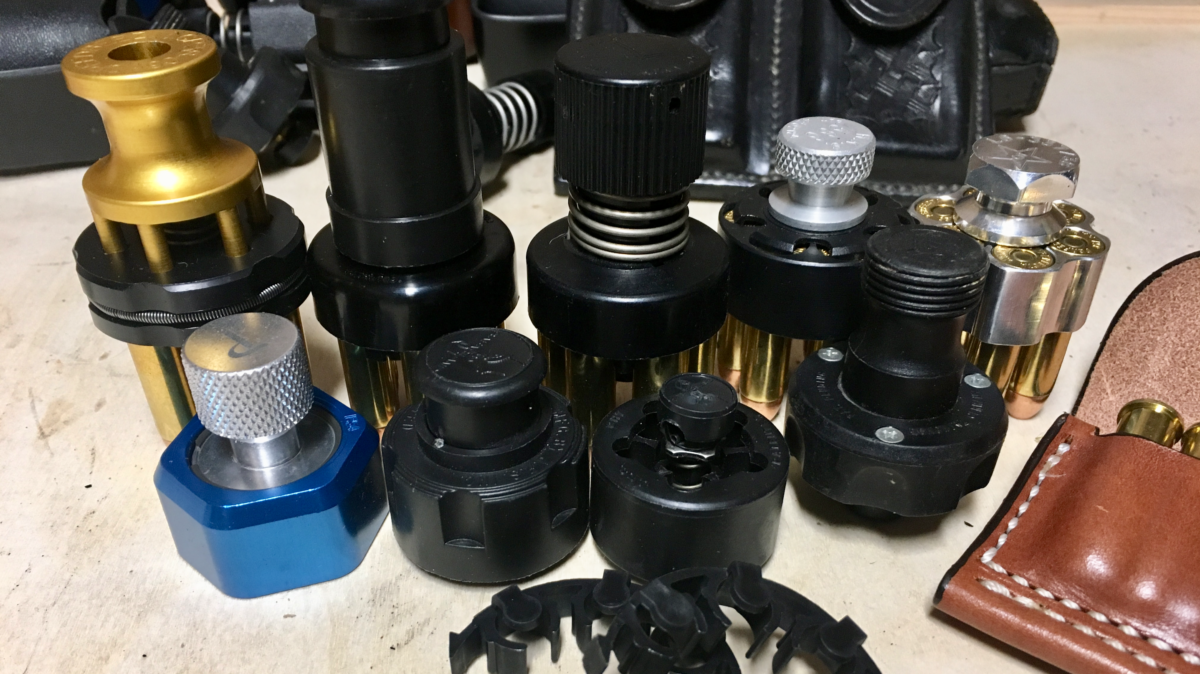
I was practicing my reloading techniques, with strips and a speed loader, at the range when an RSO stopped me. Could not point my gun at the ground when reloading, says he. No good explaining best practices to someone who knows zip about wheel guns.
Though I will speak to the owner first, I think I may cancel my membership if that is range policy. I can see it for semis.
Apparently the whole “gravity” thing escapes him as well.
Oh man… you just opened a can o’ worms.
At one of the ranges I used to go to, this one particular RSO would ALWAYS single me out about something I was doing wrong with a revolver. Even though whatever it was was sort of a preference kind of thing, it always got contorted into a safety issue. “Can’t hold your revolver like that,” “flag your hand with the muzzle when you hit the ejector rod like that,” etc.
At another, I was told I couldn’t point the revolver up in the air. Which to your point makes reloading real difficult, and again, by someone who knows zip about wheelguns.
I think you have to turn in 10 IQ points in exchange for that RSO card. Many RSOs have IQ points to spare. Some do not.
Wow, find a friend with land..
Easier said than done, haha. I’ve been looking for that friend for years!
Wait a sec . . . you don’t have your own shooting range Justin? Then what the heck have I been doing hanging around here so long? I thought for sure I’d get an invite if I stayed long enough. Ha! ; ^ )
Well, if you found yourself in Atlanta for like a 3 day layover, I’d take you to our outdoor gun club — 7 nicely reconfigured pistol bays, a 100m and 200m rifle range and a couple of shotgun ranges.
That’s definitely doable for me. I’m not Mike, but I’d take you up on it…
Got over 100 acres, but not 10 minutes from my day job 😉
Ha! Indeed! Sounds like we should be taking lessons from you.
Not shooting lessons, Mike. The family does have a way of finding rural land at good prices. We fixed up the old homestead there and I hunt there, as well as shoot long guns.
That’s exactly why I purchased 10 acres in the middle of nowhere, built a 40 meter range. I shoot from the holster, from inside a vehicle, whatever I want and practice combat reloads with my Taurus 856 weekly.
Mike,
Excellent article! I still like the scalpel technique for speed strips as that is the one I was taught back in the day (though I don’t think we knew it had a name!).
As an aside I just finished your book on Newhall. Thank you for the time and effort you put into your research and writing. The lessons written in blood at Newhall should never be forgotten, but it seems as time moves on they are unless someone like yourself pushes them to the forefront again for the rest of us to see. Thank you for reminding us. I bought a copy of your book for my department and am encouraging everyone to read it.
Thank you Morgan, MUCH appreciated! I’m glad you found the book so worthwhile, and hope your fellow officers will benefit from it as well. There’s nothing new under the sun, and the most critical combat lessons are timeless, indeed. Be safe out there, and thanks again for the praise—I’m humbled.
I’ll second that.
Thanks Bill!
Regarding the infamous RSO and range rules,,,, I too function as a CRSO at a private shooting facility. I constantly go through incidents where one guy calls fowl,,,, just because he wishes to do something which is outside the boundaries. Which by the way the “boundaries” (AKA range rules) are reviewed in person when a person joins membership,,, they are given to each person in writing in the form of a members handbook,,, and they are something that requires signing off on by each member as they renew memberships.
I get it,,,, one shooter can reload his/her revolver for 100 years, and do it stellar each & every time. Then there are others (typically the masses) who are challenged to get rounds into the cylinder the correct way. Range rules are typically established to protect the masses.
Being both shooter and CRSO on various ranges I have seen a world of crap happen, that I would have thought impossible. I have seen rounds launched into concrete floors. I have seen round cut through overhead roofs as bolts were dropped,,, and I saw a guy tip over BACKWARDS on the chair, while sending a 223 out into the parking lot between cars. Face it,,, **** happens.
Segregation among shooters would be impossible to do,,, and surely lead to rants from patrons who feel they should be up in a higher class and allowed to do more stuff. Hence the range rules to protect us all from each other. Frankly,,, I can earmark 5 or 6 right now who I would NOT want reloading a revolver while muzzling the floor. My ankles are allergic to lead!
As for how to use speed strips & speed loaders. I think its a personal choice. Hand size,,, finger strength, etc. all play a part. I can not say I can see absolute rights or wrongs.
Actually, several ranges I have been to permit different privileges to different shooters (I move a lot, and travel a lot, so I’ve shot at a LOT of ranges).
One required attendance of various classes to be given certain privileges, like drawing from the holster. Once you had attended the range’s x-hour class (and paid for it, of course), you took a test and demonstrated to the rangemaster that you were capable of drawing from the holster safely. You got that stamp on your card (or maybe a different card – it’s been a while), and from then on – unless you screwed up – you could draw from the holster. That range had a bunch of other “enhanced privileges,” too, like being able to shoot on other, more dynamic ranges, etc.
At other ranges – including one Mike and I visited in AZ a couple years back, and one that I regularly go to when I’m at Fort Bragg – one simply has to demonstrate proficiency with the rangemaster. Unless he knows you (and I’m not there quite that often) you have to ask him for permission, you’ll walk/talk him through a draw, he’ll observe you for a bit, then tell you, “yes, you’re good to go,” or “no, you still have some work to do.”
As someone who has been an RSO in various capacities, I totally get where you’re coming from. But I also know that I can tell an awful lot about someone’s knowledge, skills, and abilities by watching them handle a gun for just a little while. Bottom line, allowing different shooters different privileges isn’t impossible, but it does require some thought.
The only problem with your advice on speed strip carry, for me, is every time I try the small pocket thing my watch gets in the way.
That brings up a good point. When using the watch pocket, I find that I tend to lose a round or two when performing a reload at speed. If there is no pressure to get the strip out hastily I can do it without problem, time after time. As soon as the timer goes off, everything changes. One round almost always gets stripped away by the pocket itself; occasionally two will.
I know exactly what u mean. I carry a model 60 with an Ergo grip and recently switched From a 5 strip to a 7 with 2 2 1 spacing, whole new ballgame. Being left handed also changes things a bit. Keep up the good work.
That’s interesting! I’ve not experienced that before. Maybe the cut of the pocket is more generous on my Wranglers, or we’re grabbing the loader differently ?
I buy ALL my jeans from a local farm type store,,, TS,,, (you can guess I’m sure) but they can be purchased online as well. The brand is Schmidt. They have very wide mouths on the pockets and a large watch pocket as well. Makes a big difference.
I pocket carry my speedloaders on my weak (left) side.
Re: carrying speed strips, take a look at cell phone pouches. Sizes come small enough for one, or big enough for two or three. I carry one by Raine (look at raineinc.com) that I got cheap at what we used to call the Army surplus store.
I’ve been carrying a pair of speed loaders in a cheap nylon pouch for a while, but need to upgrade to a good leather set.
Good article, buncha good things to think about. Ace
Thanks Ace! Always good to see you here!
Back in the 80s we were all carrying SW 25-5s in .45 Colt. I literally had time to shoot 12 rounds from the 5 yard line, strong and weak hand, and smoke a cigarette before the rest of the line finished firing. The RO complimented me on being one of the few who actually practiced with my HKS speedloaders.
Attended your Newhall lecture at the Pat Rogers Roundup this year. Great advice on speed loaders. Revolvers and the attendant accessories require more practice and attention to detail than your basic Glock variants.
Those of us ‘geezers’ who were basically weaned on a K-frame smith understand this requirement.
I worry over the multitude of CHL folks who carry the J-frames because “they” are light and concealable w/o ever doing much beyond function testing…of course it’s better than a sharp stick, but no substitute for enhanced instruction and Lots of range time
Great to hear from you Sir, and thanks for attending the lecture!
Yes, keeping the revolvers loaded takes a little more work. It’s the tradeoff we accept for all the other benefits.